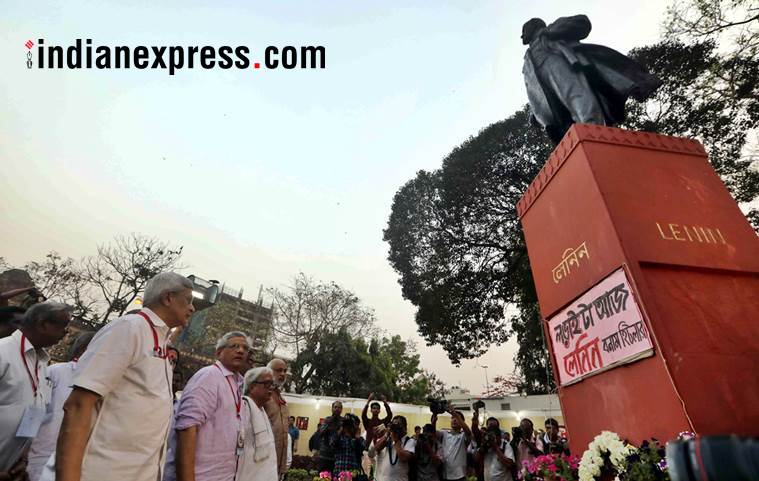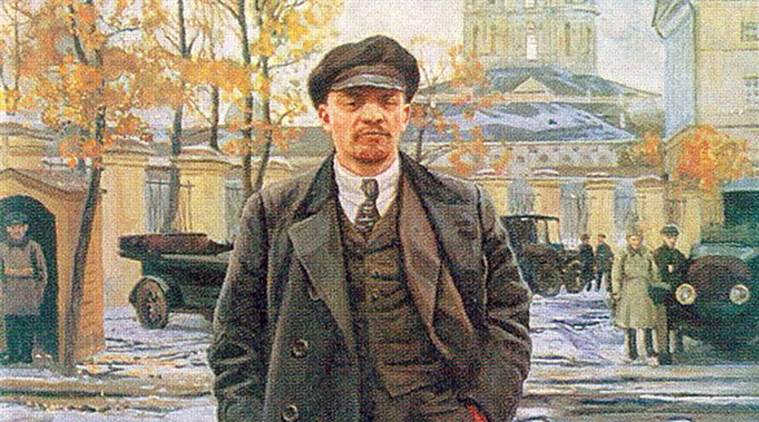Lenin Babu Still Lives in Dharmatala
Vladimir Ilyich Ulyanov was once everywhere in Kolkata. And his bounty was not just revolution.
 The Lenin statue in Kolkata (Express Photo by Partha Paul)
The Lenin statue in Kolkata (Express Photo by Partha Paul)
Three brothers lived next door to us in Kolkata. One followed the CPI(M), one the CPI and the third was die-hard Forward Bloc. As children, we did not quite understand the difference between Lenin and Mao, or the divide between Moscow and Beijing. On Subhas Chandra Bose’s birthday, the Forward Bloc brother always hung a giant photograph of Netaji from the balcony. Their cousin, who stayed in the room facing that balcony, was a Congress supporter. They all lived in the same house. The party loyalties were fierce but no statues were ever beheaded to score political points.
Frankly, most of us did not know what the Leninist in Communist Party of India (Marxist-Leninist) stood for exactly. But everyone knew of Lenin. In 1970, the Communist babus of Bengal commemorated his centenary for an entire week in Eden Gardens and decreed that the bustling Dharmatala Street, with its trundling trams and crumbling mansions, would become Lenin Sarani. That’s what it became, along with a statue of Lenin in his billowing overcoat. In more Lenin largesse, Garulia in north 24 Parganas was rechristened Lenin Nagar.
Strangely, we did not think it odd that a dead Russian still walked among us, that his picture, often in three-quarter profile, in revolutionary red, black and white, popped up on posters, exhorting us to march to the Brigade Parade ground. Che Guevara looked more dashing, but Lenin could almost be a Bengali bhadralok, a balding uncle, the kind who sits in Bengal Club, strokes his beard and drinks whisky. Thanks to his jacket and tie, Lenin would actually be allowed inside such clubs.
 Painting of Lenin in front of the Smolny Institute by Isaak Brodsky
Painting of Lenin in front of the Smolny Institute by Isaak Brodsky
In turbulent times, Lenin loomed large. In Shottorer Dinguli, a memoir of the Naxalite uprising, Debashis Bhattacharya remembers the police crackdowns of the early 1970s. “Many became afraid, gave up leftist politics and ran away,” he wrote. “After all, how many could say, facing the police’s and Congress goondas’ revolvers, ‘Facing death, I think I am Lenin’?”
ALSO READ | How Vladimir Lenin influenced Indian revolutionaries
A friend shares a biting story that Subimal Misra wrote about an evening in 1972, when two stray bulls landed up at the intersection of Chowringhee and Lenin Sarani, butting each other, causing pandemonium while a bare-bodied man in a green lungi pissed near Lenin’s statue. Chased by gun-toting politicians and lathi-charging police, who warned that bulls were really Communist extremists, the terrified animals ran into the Art Deco Metro movie theatre where a packed house was watching Mrinal Sen’s Calcutta 71 about Naxalites and the starving everyman. Finally, the bulls were killed, their dried blood staining the ground just a few feet from Lenin’s statue.
But, for most of us, Lenin’s bounty was not revolution but books. Russian books were plentiful, colourful and dirt cheap, thanks to a Soviet propaganda brainwave to catch ’em young. In The Namesake, Jhumpa Lahiri writes about her Gogol, that “he hates that his name is both absurd and obscure, that it has nothing to do with who he is, that it is neither Indian not American, but, of all things Russian.” But really, for most Bengalis, Gogol is now as Bengali as Poltu or Khoka. We still live next door to one.
We grew up with Maxim Gorky and Anton Chekhov, fairy tales about Baba Yaga witches in houses with chicken’s feet, Yakov Perelman’s Physics For Entertainment and an enthralling book about children who had tiger cubs and foxes as pets in Alma-Ata. There were Russian books from Progress Publishers and Raduga Press translated into Bengali. We did not think it strange that entire shops like Bingsha Shatabdi and Manisha Granthalaya were devoted to everything Soviet. Satyajit Ray designed the logo for Manisha Granthalaya, the painter Jamini Roy gifted it a painting, the poet Bishnu Dey gave its name. What could be more Bengali highbrow street cred than that?
Later, I discovered horrifying stories of banished writers and massacres and gulags. But growing up, those Russian books were simply part of being Bengali. Just like the wooden Matryoshka dolls, one doll fitting into another into another. Bengali middle-class homes unfailingly had one in the “dollcabinet” in the living room. And we all thought chicken a la Kiev at Sky Room oozed buttery continental sophistication.
Now, those dozens of stalls selling Russian books in Bangla have vanished from the Kolkata book fair although there’s still a blog for Soviet Books in Bengali. Lenin has faded from the cultural imagination though his dusty statue still presides over the street that bears his name. A symbol of Russian camaraderie persists underground. The Metro train built with Soviet help, the first in India, is still going strong.
Does the ghost of Lenin wander onto the Metro? Or haunt the hip new Milee Droog café in Gorky Sadan, the Russian consulate, and sample the blinis and the borscht on the menu, servings of Russian nostalgia, alongside Cajun potatos and Mexican tacos? Does he sneak into its famous chess club? Or at a time when Leningrad has become St Petersburg, and the Communists swept from power in Bengal, is he just grateful to still have a street to his name?
He should count himself lucky. At least in Kolkata, Lenin still has his head. For now.
- 01
- 02
- 03
- 04
- 05































